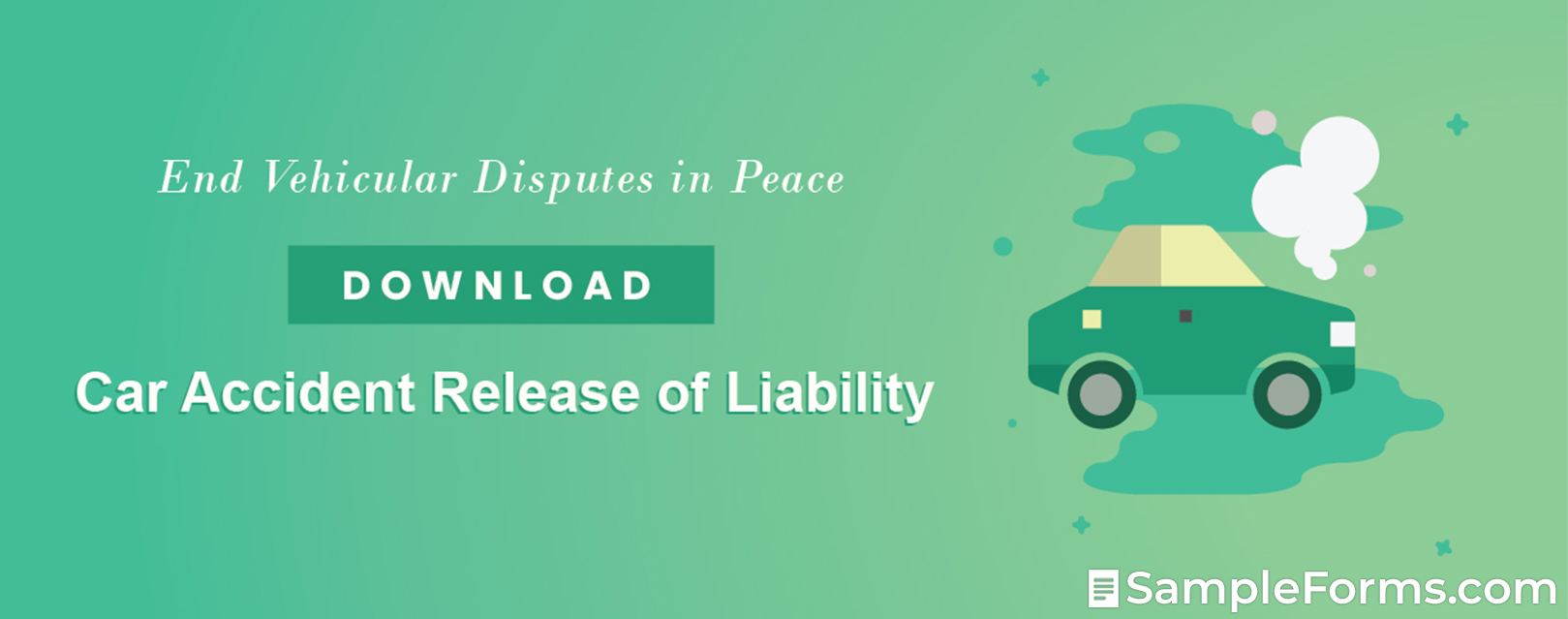

Car accidents are a part of the daily hustle. When two drivers decide to settle it, it usually ends in either way: by mutual agreement or by filing a case. The latter can be avoided by seeing eye to eye with the other party. A car accident release of liability form will help you settle a dispute peacefully. In this document, the other party will not be absolved of their responsibility. Instead, you waive your right to sue them in exchange for payment. Learn more about the contents of this release form by reading below. Read More
Download PDF
Download Word
A car accident release of liability form is a legally binding document that settles a dispute between two parties outside of court. This is a mutual agreement between two parties wherein the party at fault agrees to provide payment to the other party. This is done to prevent the other party from filing a case against the party at fault. The payment shall cover the property damage, personal hardship, compensation for loss of employment, and hospitalization dues. This is also known as a settlement agreement.
According to Driver Knowledge, an average of 6 million car accidents happen in a year. And about 72% of these result in property damage. No matter how careful you are on the road, you’ll eventually end up being involved in a car accident because of some reckless driver. A car accident release of liability form will help settle the dispute peacefully. Below are tips on how to make one:
Start by introducing the releasor and the releasee. The releasor is the victim of the car accident. Whereas the releasee is the one at fault. Include only the full names of both parties in this section. Both parties should be identified as to who the releasor and the releasee are. If there are more than two persons at fault, include them in the agreement.
In most cases, the releasee’s auto insurance company will cover all the expenses needed. These are the hospitalization dues, property damage, compensation for loss of employment, and personal hardship. The details of the injury and property damage should be specified in order for the insurance company to cover the expenses justly. Once the release form has been signed, the releasor can no longer claim future obligations and/or damages from the releasee and the insurance company.
Like what has been previously mentioned, the amount offered by the insurance company has to cover all fees pertaining to the accident. That’s why it’s very important to specify all injuries and damages for the insurance company to justly cover them. If you cannot provide the exact amount, you can estimate all future costs.
The release form must be in compliance with its governing laws. Otherwise, the whole document will be considered as invalid and unenforceable. In case of future disputes, the governing law will be used to uphold any decision made by the court. Be on the safe side and get educated by your state’s laws.
When in doubt, don’t hesitate to consult a personal injury lawyer. Normally, some insurance companies will try to save time and money by settling the claim quickly. If you are not satisfied with the amount, consult your personal injury attorney to ensure the amount is justly set. Take your time and don’t sign the document immediately.
It entirely depends on you. However, some states require you to notarize your release of liability. If you belong to the states that don’t require notarization, still, it is highly recommended that you do for extra protection. A notarized document also guarantees the agreement’s validity.
The first step is to gather information about the accident. The police should be involved during this process to capture images, make an accident report, and to determine who is at fault. An agreement will now be made between the two parties. Second, the releasee is made aware of the injuries and damages that they have sustained. The release form must be established immediately to prevent a long list of claims and damages by the releasor. Third, the dispute must be settled. A background check must be done to ensure the releasor has not been previously involved with insurance fraud. Lastly, once everything has been finalized, the release should be signed by both parties.
The release of liability form or the hold harmless agreement consists of the releasor and the releasee. The releasor is the victim of the accident while the releasee is the person being released from the liability.
Yes, According to Which. However, you have to inform them within the required window. If you fail to do this, they have the right to refuse to cover you.
Yes. It is acceptable to pay out of pocket for a car accident.
Responsible drivers try to avoid accidents as much as possible. Aside from the trauma, financial loss, property damage, and possible death are the things that should be rightfully avoided. But no matter how careful you are on the road, road mishaps happen because of irresponsible drivers. These drivers have no regard for human life. One way of holding them accountable is through the use of a car accident release of liability. Practically, nobody wants to go through the long and arduous process of legal methods. That’s why it’s wise to settle everything by paying a hefty sum of money to the releasor. As the releasor, you should be wise enough to ensure that the amount covers all claims and damage. But all these will be unnecessary as long as everyone practices safe driving.
Instantly complete the preparation of essential documents within minutes by choosing this convenient and simple, innovative solution.